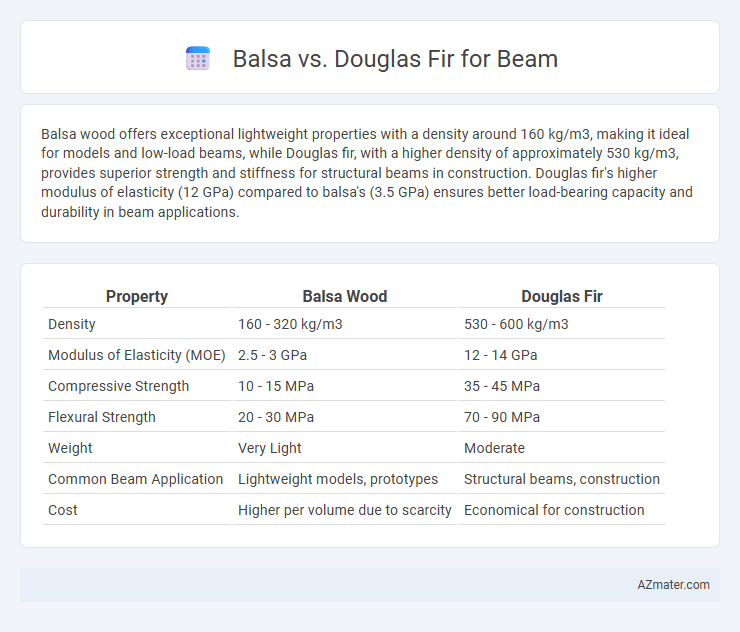Balsa wood offers exceptional lightweight properties with a density around 160 kg/m3, making it ideal for models and low-load beams, while Douglas fir, with a higher density of approximately 530 kg/m3, provides superior strength and stiffness for structural beams in construction. Douglas fir's higher modulus of elasticity (12 GPa) compared to balsa's (3.5 GPa) ensures better load-bearing capacity and durability in beam applications.
Table of Comparison
| Property | Balsa Wood | Douglas Fir |
|---|---|---|
| Density | 160 - 320 kg/m3 | 530 - 600 kg/m3 |
| Modulus of Elasticity (MOE) | 2.5 - 3 GPa | 12 - 14 GPa |
| Compressive Strength | 10 - 15 MPa | 35 - 45 MPa |
| Flexural Strength | 20 - 30 MPa | 70 - 90 MPa |
| Weight | Very Light | Moderate |
| Common Beam Application | Lightweight models, prototypes | Structural beams, construction |
| Cost | Higher per volume due to scarcity | Economical for construction |
Overview: Balsa vs Douglas Fir as Beam Materials
Balsa and Douglas fir are distinct beam materials with unique properties suited for different structural demands. Balsa is exceptionally lightweight and has a high strength-to-weight ratio, making it ideal for applications requiring minimal weight, such as model building and certain aerospace components. Douglas fir offers greater density and strength, providing excellent load-bearing capacity and durability for construction projects like framing, flooring, and heavy timber structures.
Wood Density and Weight Comparison
Balsa wood has an exceptionally low density of about 160 kg/m3, making it one of the lightest commercial woods available, while Douglas fir has a much higher density of approximately 530 kg/m3. This significant difference means balsa beams are substantially lighter but lack the same structural strength and stiffness that the denser Douglas fir beams provide. For applications requiring minimal weight with limited load-bearing demands, balsa is advantageous, whereas Douglas fir is preferred for robust, durable beam construction due to its superior density and weight-bearing capacity.
Strength and Structural Performance
Douglas fir beams exhibit superior strength and structural performance compared to balsa, with a higher density of approximately 530 kg/m3 versus balsa's 160 kg/m3, resulting in better load-bearing capacity and stiffness. Douglas fir provides excellent resistance to bending, shear, and compression forces, making it ideal for structural applications requiring durability and stability. Balsa's lightweight nature offers limited strength, primarily suitable for non-load-bearing or lightweight structures where minimal weight is crucial.
Durability and Resistance to Elements
Douglas fir beams exhibit superior durability and resistance to elements compared to balsa, making them ideal for structural applications exposed to moisture and varying weather conditions. Balsa wood, while lightweight and easy to work with, is significantly less dense and more prone to rot, decay, and insect damage when used in outdoor or high-moisture environments. Douglas fir's natural resin content and tighter grain structure enhance its resistance to fungal growth and weathering, ensuring longer-lasting performance in beams.
Workability and Ease of Construction
Balsa wood offers exceptional workability due to its lightweight, soft texture, and ease of cutting, shaping, and sanding, making it ideal for precision beam construction in model or lightweight structures. Douglas fir, while denser and harder than balsa, provides superior strength and stability but requires more effort and specialized tools to cut and join effectively during beam fabrication. The choice between balsa and Douglas fir hinges on balancing ease of construction with structural demands; balsa excels in effortless manipulation, whereas Douglas fir delivers robust beam performance at a higher labor cost.
Cost Analysis: Balsa vs Douglas Fir
Balsa beams are significantly more expensive than Douglas fir due to their lightweight and limited availability, with prices often exceeding $10 per board foot compared to Douglas fir's $2-$4 range. Douglas fir offers a cost-effective solution for structural beams, balancing strength and affordability, making it ideal for large-scale construction projects. When considering long-term value, Douglas fir's durability and widespread use reduce replacement and maintenance costs, enhancing overall cost efficiency compared to balsa.
Sustainability and Environmental Impact
Balsa wood, known for its rapid growth and high carbon sequestration rate, offers a more sustainable option compared to Douglas fir, which grows slower and requires more extended harvesting cycles. The environmental impact of balsa is lower due to its lightweight nature, reducing transportation emissions and energy use in structural applications. Douglas fir, while durable and strong, involves greater ecological footprints through land use changes and slower forest regeneration rates, making balsa the preferred choice for eco-conscious beam construction.
Common Applications in Construction
Balsa wood, known for its exceptional lightweight and high strength-to-weight ratio, is commonly used in model-making, prototyping, and lightweight structural components where minimal load is applied. Douglas fir, prized for its durability and load-bearing capacity, is extensively utilized in heavy construction projects such as framing, beams, and trusses in residential and commercial buildings. Both woods serve distinct roles; Balsa excels in applications demanding lightness and ease of shaping, while Douglas fir is preferred for structural integrity and longevity in load-bearing applications.
Maintenance and Longevity
Balsa wood requires minimal maintenance due to its natural resistance to moisture but is less durable and prone to damage under heavy loads compared to Douglas fir. Douglas fir offers superior longevity with its high strength-to-weight ratio, making it more suitable for structural beams that bear significant weight over time. Regular treatments and inspections extend the lifespan of Douglas fir beams, while balsa is often chosen for lightweight, low-stress applications requiring less maintenance.
Final Recommendation: Best Wood for Beams
Douglas fir stands out as the best wood for beams due to its superior strength, durability, and load-bearing capacity, making it ideal for structural applications. Balsa, while lightweight and easy to work with, lacks the necessary density and strength required for reliable support in beams. For long-lasting and safe beam construction, Douglas fir is the recommended choice based on its excellent mechanical properties and widespread use in construction.

Infographic: Balsa vs Douglas fir for Beam
 azmater.com
azmater.com